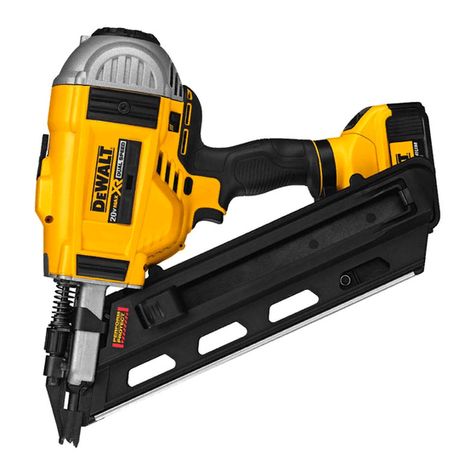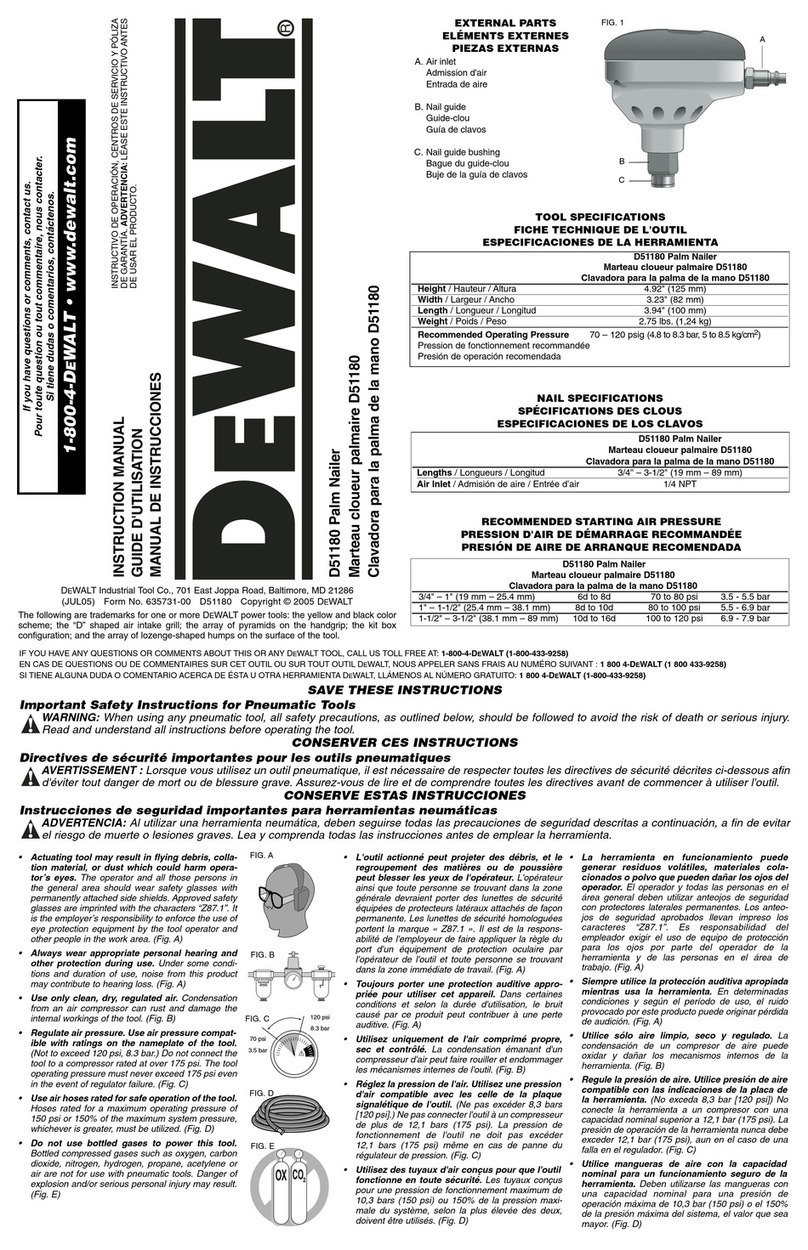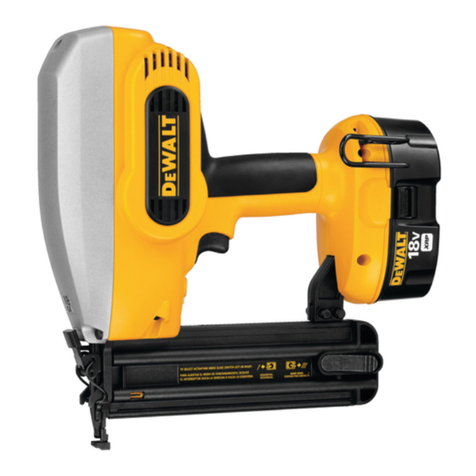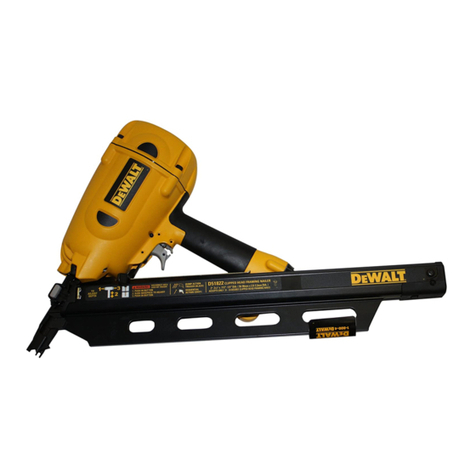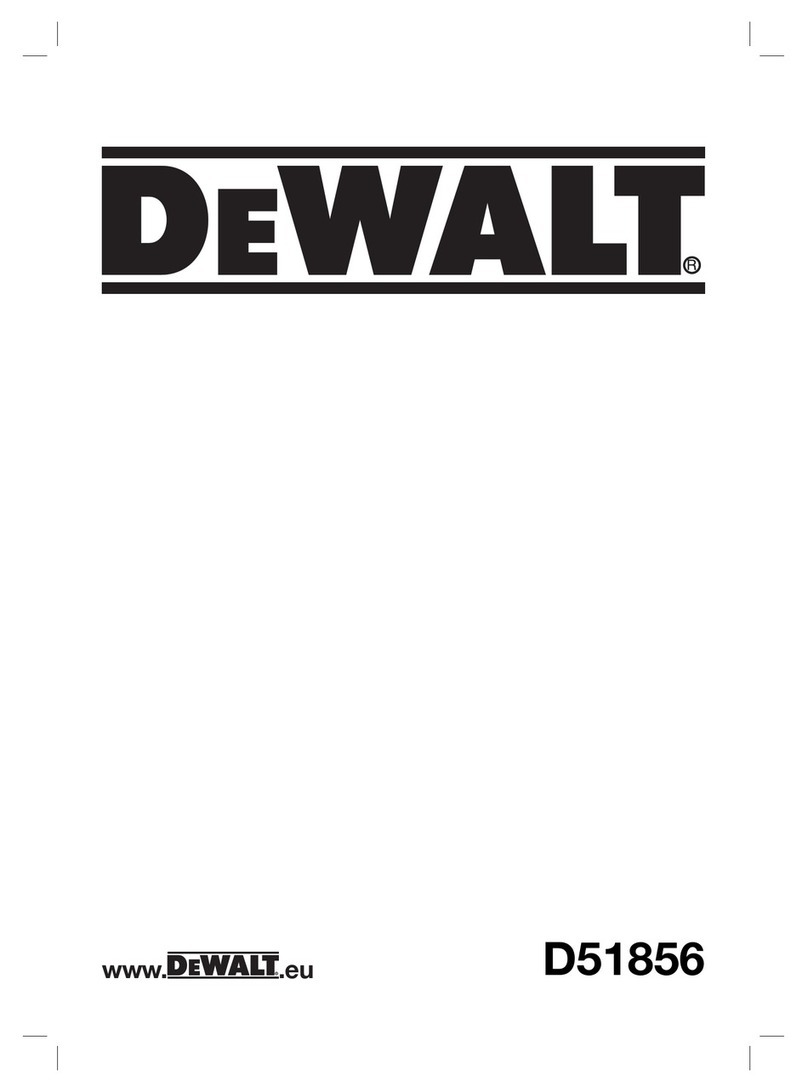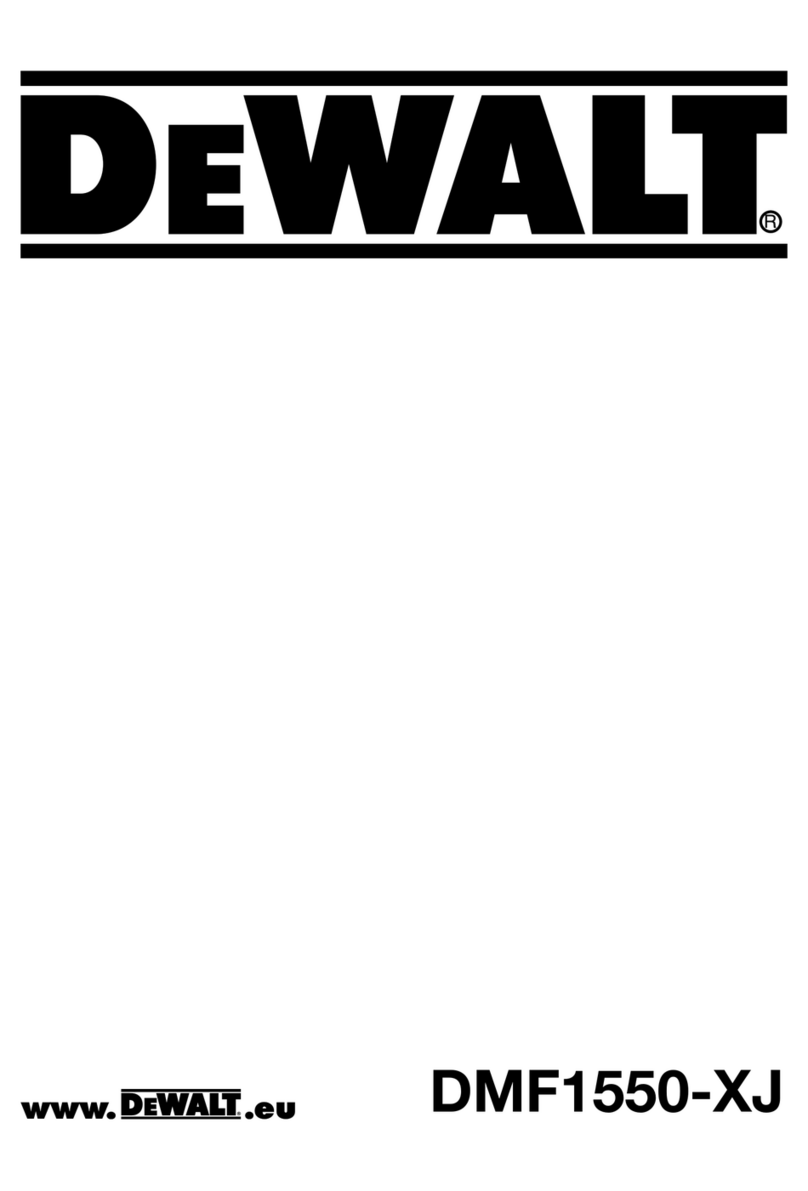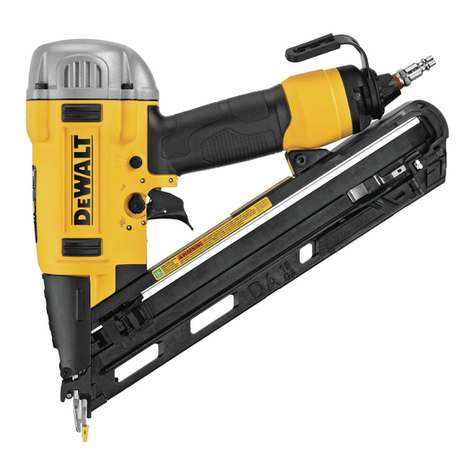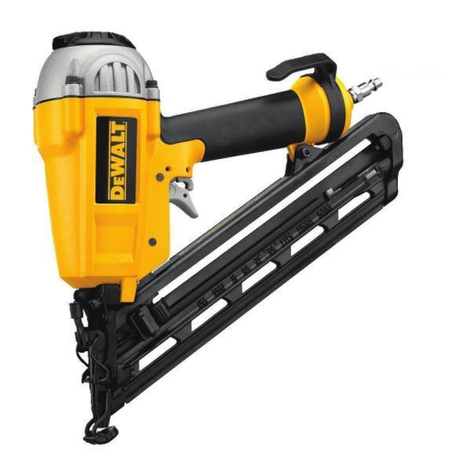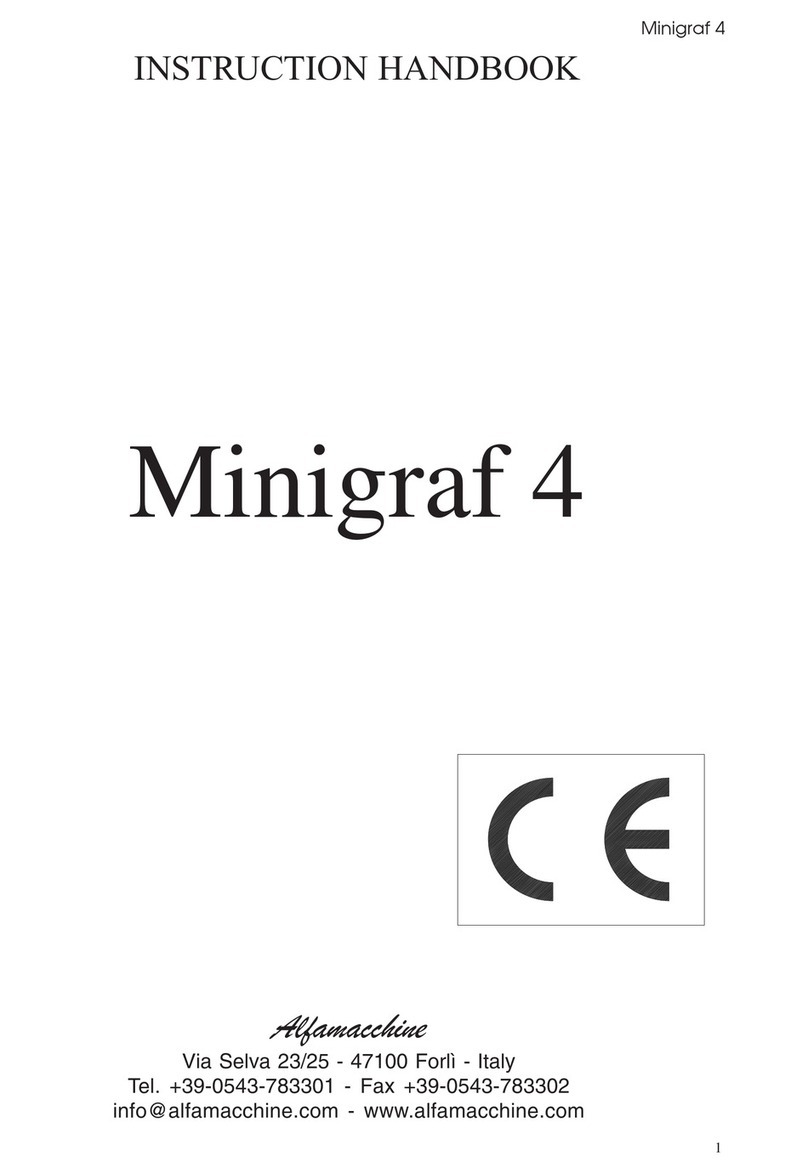
6
ENGLISH
WARNING: NEVER spray or in any other way apply
lubricants or cleaning solvents inside the tool. This can
seriously affect the life and performance of thetool.
WARNING: if the tool has been dropped or you suspect
tool damage perform tool operation check as defined in
the Mode selection section of the manual. If it doesn’t
perform according to the manual, stop using the tool and
have it serviced at an authorised DeWALT servicecentre.
• Hold tool by insulated gripping surfaces when
performing an operation where driven fastners may
contact hidden wiring. Contact with a “live” wire will make
exposed metal parts of the tool “live” and shock theoperator.
• Always wear appropriate personal hearing and other
protection during use. Under some conditions and duration
of use, noise from this product may contribute to hearingloss.
• Disconnect battery pack from the tool when not in use. Always
remove battery pack and remove fasteners from magazine
before leaving the area or passing the tool to another
operator. Do not carry tool to another work area in which
changing location involves the use of scaffoldings, stairs,
ladders, and the like, with battery pack connected. Do not
make adjustments, perform maintenance or clear jammed
fasteners while battery is inplace.
• Do not remove, tamper with, or otherwise cause the
tool, trigger, trigger lock‑off, or contact trip to become
inoperable. Do not tape or tie trigger or contact trip in the
on position. Do not remove spring from contact trip. Make
daily inspections for free movement of trigger and contact trip.
Uncontrolled discharge couldresult.
• Inspect tool before use. Do not operate a tool if any
portion of the tool, trigger, trigger lock‑off, or contact
trip is inoperable, disconnected, altered, or not working
properly. Damaged parts or missing parts should be repaired
or replaced before use. Refer toMaintenance.
• Do not alter or modify the tool in anyway.
• Always assume that the tool containsfasteners.
• Do not point the tool at co‑workers or yourself at
any time. No horseplay! Work safe! Respect the tool as a
workingimplement.
• Do not carry the tool from place to place holding the
trigger. Accidental discharge couldresult.
• Always use trigger lock‑off when tool is not in
immediate use. Using the trigger lock‑off will prevent
accidentaldischarge.
• Do not overreach. Maintain proper footing and balance at all
times. Loss of balance may cause personalinjury.
• Use the tool only for its intended use. Do not discharge
fasteners into open air, concrete, stone, extremely hard
woods, knots or any material too hard for the fastener
to penetrate. Do not use the body of the tool or top
cap as a hammer. Discharged fasteners may follow an
unexpected path and causeinjury.
• Always keep fingers clear of contact trip to prevent
injury from inadvertent release of thepusher.
• Always operate the tool in a clean, lighted area. Be sure
the work surface is clear of any debris and be careful not to
Additional Nailer Safety Warnings
WARNING: When using any nailer, all safety precautions,
as outlined below, should be followed to avoid the risk
of death or serious injury. Read and understand all
instructions before operating thetool.
the workpiece, the fastener may be deflected away from
yourtarget.
• Disconnect the tool from the power source when the
fastener jams in the tool. While removing a jammed
fastener, the nailer may be accidentally activated if it is
pluggedin.
• Use caution while removing a jammed fastener. The
mechanism may be under compression and the fastener
may be forcefully discharged while attempting to free a
jammedcondition.
• Do not use this nailer for fastening electrical cables. It is
not designed for electric cable installation and may damage
the insulation of electric cables thereby causing electric shock
or firehazards.
• Always wear safetyglasses.
• Always wear earprotection.
• Only use fasteners of th e type specified in themanual.
• Do not use any stands for mounting the tool to asupport.
• Do not disassemble or block any parts of the fastener driving
tool such as the contacttrip.
• Prior to each operation check that the safety
and triggering mechanism is functioning properly and that all
nuts and bolts aretight.
• Do not use the tool as ahammer.
• Do not use the DCN662
ʵ when changing from one driving location to another
involving the use of scaffoldings, stairs, ladders or
ladder‑like constructions, e.g., roof laths, etc.;
ʵ when closing boxes or crates;
ʵ when fitting transportation safety systems, e.g., on
vehicles, wagons,etc.
For exemptions check your local national
workplaceregulations.
• Always check local workplaceregulations.
• Never point any operational fastener driving tool at yourself or
at any otherperson.
• While working, hold the tool in such a way that no injuries can
be caused to the head or to the body in the event of a possible
recoil due to a disruption in the energy supply or hard areas
within the workpiece.
• Never actuate the fastener driving tool into freespace.
• In the work area, carry the tool at the workplace using only
one handle, and never with the triggeractuated.
• Consider the conditions in the work area. Fasteners can
penetrate thin work pieces or slip off corners and edges of the
work piece, and thus put people atrisk.
• Do not drive fasteners close to the edge of the workpiece.
• Do not drive fasteners on top of otherfasteners.



